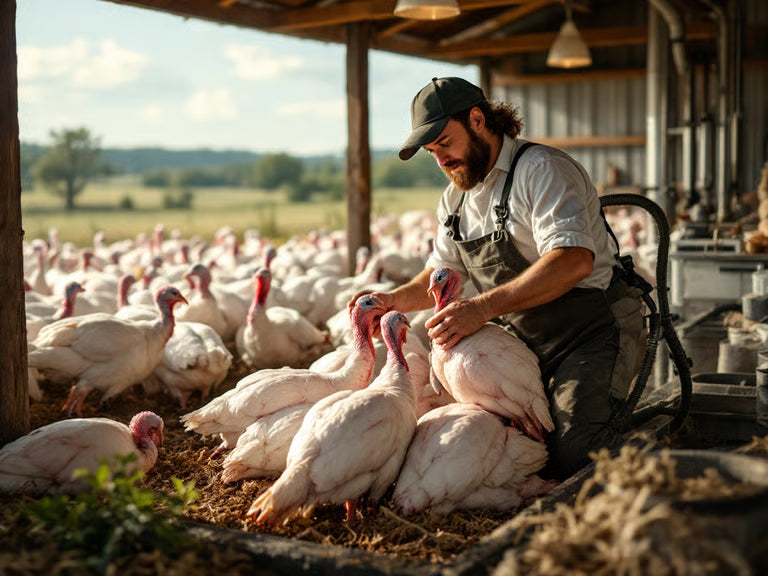Picture this: you’re on your small farm in California, the sun’s just peeking over the coop, and it’s time for the live turkey slaughtering process. Handling live turkeys for Thanksgiving may sound daunting, but you’ll find it surprisingly straightforward when you break it into clear steps. By the end of this guide, you’ll feel confident planning your day, processing your bird humanely, and getting it ready for the oven.
Ready to get started? Let’s walk through everything you need to know.
Plan Your Slaughter
Before you touch a bird, you’ve got to dot your i’s and cross your t’s.
- Check local rules: California has specific live turkey regulations in california.
- Secure permits: find out if you need any live turkey permits for thanksgiving.
- Gather equipment: prepare killing cones, sharp knives, buckets, and a plucker.
- Prep space: set up two sturdy tables—one for plucking, one for eviscerating.
- Ready helpers: line up friends or family for an assembly-line workflow.
Tip: for quality poults and hatching eggs, swing by avbirds.com’s turkey poults and hatching eggs for stock you can trust (https://avbirds.com/turkey-poults-and-hatching-eggs).
Herd and Transport
Getting birds from pen to processing area safely keeps stress—and tough meat—at bay.
-
Timing matters
Move turkeys in the cool morning hours to avoid heat stress. -
Use gentle herding
Quiet voices, dim lights, and slow movements help prevent flapping. -
Weather prep
Wondering about rain or heat? Cover trailers with breathable tarps and watch temperatures during the live haul.
Remember, every bird you handle gently will taste better on your holiday table.
Render Turkey Insensible
A humane stunning method ensures you end suffering and meet welfare standards.
- Employ killing cones (often made from buckets) to position the turkey upside down (Bon Appétit).
- Cut the jugular and carotid arteries quickly with a sharp knife.
- Allow full blood drainage into a bucket before proceeding.
One swift, clean cut means minimal stress for your bird, and a safer process for you.
Scald and Remove Feathers
Scalding loosens feathers for faster plucking. Aim for these temps:
| Method | Temperature | Time |
|---|---|---|
| Warm Scald | 145°F (63°C) | 3–4 minutes |
| Hot Scald | 155°F (68°C) | 1–2 minutes |
Follow with a motorized plucker or hand-pluck gently to avoid tearing skin (The Prairie Homestead). Rinse the bird afterward to clear out loose feathers.
Eviscerate and Rinse
Now you’ll open and clean the turkey cavity.
- Lay the bird on its back and make a small incision above the breastbone.
- Reach in carefully, removing organs (save heart, liver, and gizzard if you like).
- Rinse inside and out with cool water to remove debris.
- Trim off the oil gland at the tail end to avoid off-flavors.
A clean cavity means safer storage and better flavor when you roast.
Portion the Carcass
Splitting the turkey makes storage and cooking easier.
-
Halve the turkey
Slice down each side of the backbone to create two even halves (MeatEater). -
Separate legs and thighs
Cut at the joint for braising cuts or sandwiches. -
Slice boneless breasts
Peel meat slowly from the ridge for intact fillets.
Portioning now saves you time and fridge space later.
Dispose Waste and Clean
Proper disposal and sanitation keep your yard—and neighbors—happy.
- Bag feathers and offal for compost or local disposal services.
- Sanitize tools and tables with a bleach solution (1 tablespoon per gallon of water).
- Rinse all containers and work surfaces, then air-dry.
If you need tips on eco-friendly cleanup, see live turkey disposal methods after thanksgiving.
Chill and Store Turkey
Quick chilling prevents bacteria and locks in juiciness.
- Submerge bird or portions in ice water for several hours.
- Transfer to a fridge for 24–48 hours before wrapping.
- Label and date packages for easy thawing and meal prep.
Once chilled, you’re ready for live turkey cooking instructions for thanksgiving.
Key Takeaways
- Check California rules and have all permits ready.
- Handle birds calmly during herding and stunning.
- Scald, pluck, and eviscerate with clean tools.
- Portion, chill, and store for peak flavor.
Give this process a try to master your Thanksgiving turkey from farm to feast. Have questions or tricks of your own? Drop a comment below so everyone can learn together.

